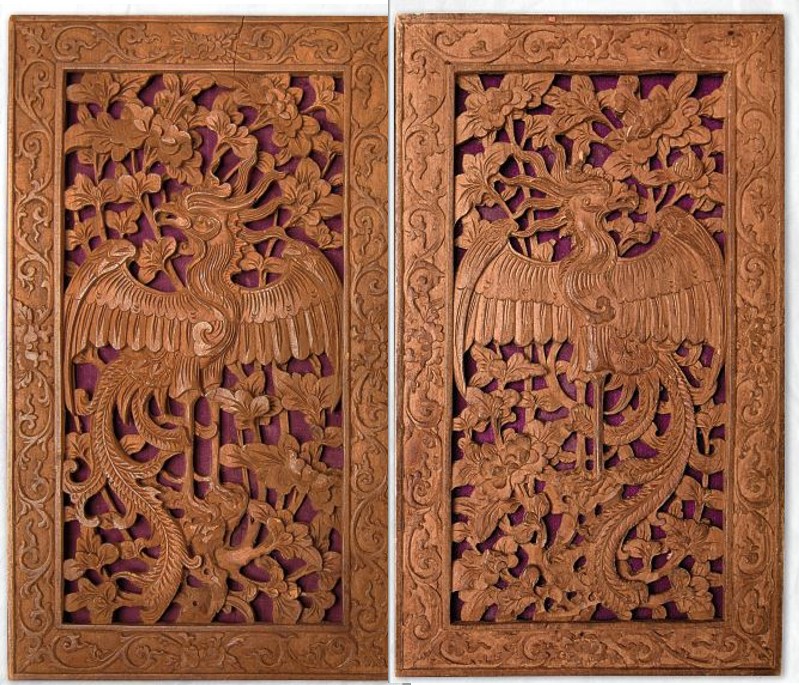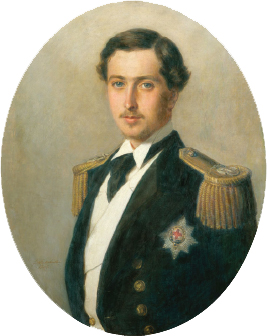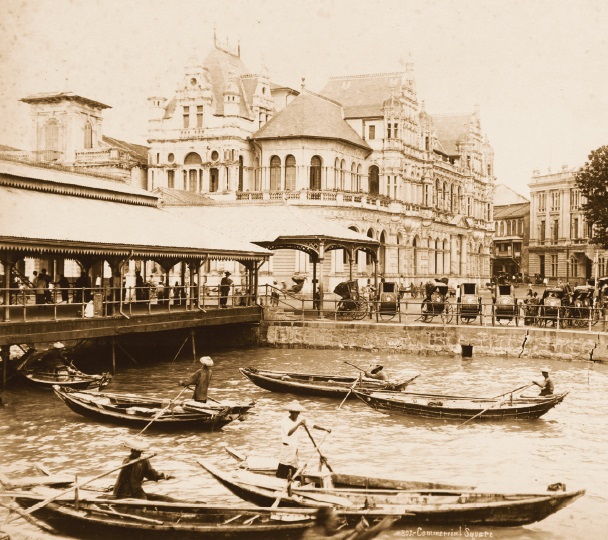A Tribute Fit For A Prince
Creator: Unknown
Year created: 25 November 1869
Language: English and Chinese
Type: Manuscript; double-sided folded sheet with carved wooden front and back covers
Call no.: RRARE 959.5703 ADD
Accession no.: B20048303I
Donated by: Geoffrey Edwards
 The front and back wooden covers of the Loyalty Address – created in homage to Price Alfred, the Duke of Edinburgh – are intricately handcraved with phoenixes. All rights reserved, National Library Board, Singapore.
The front and back wooden covers of the Loyalty Address – created in homage to Price Alfred, the Duke of Edinburgh – are intricately handcraved with phoenixes. All rights reserved, National Library Board, Singapore.Singapore has never hesitated to roll out the red carpet for visiting dignitaries, and this is exactly what a British royal experienced when he sailed into Singapore nearly 150 years ago.
In December 1869, Prince Alfred, Duke of Edinburgh and Queen Victoria’s second son, paid a visit to Singapore on the HMS Galatea.1 As his tour marked the first time a member of the British royal family was to set foot in Malaya,2 officials and merchants scrambled to prepare for his arrival with a suitably grand programme of entertainment.3
 Portrait of Prince Alfred, Duke of Edinburgh, by the German painter Franz Xaver Winterhalter, 1865. All rights reserved, Ormond, R., & Blackett-Ord, C. (1987). Franz Xaver Winterhalter and the Courts of Europe 1830–70. London: National Portrait Gallery Publications. Courtesy of Wikimedia Commons.
Portrait of Prince Alfred, Duke of Edinburgh, by the German painter Franz Xaver Winterhalter, 1865. All rights reserved, Ormond, R., & Blackett-Ord, C. (1987). Franz Xaver Winterhalter and the Courts of Europe 1830–70. London: National Portrait Gallery Publications. Courtesy of Wikimedia Commons.The Chinese community in particular was anxious not to be outdone. More than 80 leading members of the upper crust of Chinese society came together to sign a Loyalty Address to Prince Alfred, taking advantage of the opportunity to showcase the community’s prosperity and display their political allegiance to the Queen.4 Among the group were men who were considered as the colony’s leading lights of industry: Tan Kim Ching, the eldest son of Tan Tock Seng; Seah Eu Chin, who helped set up Ngee Ann Kongsi; businessman and philanthropist Cheang Hong Lim; Tan Seng Poh, the first Chinese person appointed as a Municipal Commissioner in Singapore; and Hoo Ah Kay (Whampoa), a wealthy businessman.5
On 3 December 1869, the very day the prince landed in Singapore, likely at Johnston’s Pier near Fullerton Square, the Loyalty Address – dated 25 November 1869 – was presented to him as a symbol of the Straits Chinese community’s loyalty and gratitude.6
 A view of Johnston’s Pier with Commercial Square (present-day Raffles Place) in the background. Prince Alfred most likely disembarked from Johnston’s Pier when he arrived in Singapore. Fotoalbum Singapur by G. R. Lambert & Co. (1890). All rights reserved, National Library Board, Singapore.
A view of Johnston’s Pier with Commercial Square (present-day Raffles Place) in the background. Prince Alfred most likely disembarked from Johnston’s Pier when he arrived in Singapore. Fotoalbum Singapur by G. R. Lambert & Co. (1890). All rights reserved, National Library Board, Singapore.The Address is suitably grand for a royal recipient, with the message written on six panels of fuchsia-coloured silk, folded into a single sheet and with front and back covers made of carved wood. Phoenixes were carved into the wooden panels such that when the document is opened they appear to be facing each other across the expanse of silk. The reverse side of the Address is a panorama of Singapore viewed from Telok Ayer, executed on cream-coloured silk and inspired by an oil painting by the English artist Percy Carpenter (1820-95).
 The message on the Loyalty Address was written in gold ink on six panels of fuchsia-coloured silk folded into a single sheet. All rights reserved, National Library Board, Singapore.
The message on the Loyalty Address was written in gold ink on six panels of fuchsia-coloured silk folded into a single sheet. All rights reserved, National Library Board, Singapore. The reverse side of the Loyalty Address features a painting of Singapore viewed from Telok Ayer by an unknown artist. The scene portrayed is inspired by the 1856 oil painting “Singapore from Mount Wallich” by the English artist Percy Carpenter but drawn from a higher vantage point. All rights reserved, National Library Board, Singapore.
The reverse side of the Loyalty Address features a painting of Singapore viewed from Telok Ayer by an unknown artist. The scene portrayed is inspired by the 1856 oil painting “Singapore from Mount Wallich” by the English artist Percy Carpenter but drawn from a higher vantage point. All rights reserved, National Library Board, Singapore.Written in gold Chinese characters and with an accompanying English translation, the rather overblown Address reads:
We the Singapore Chinese merchants, Inhabitants & Public with purity of heart and Sincerity collectively approach in humble attitude to present this address. To The 2nd Prince of the Illustrious Queen of Great Britain and Ireland, Alfred Duke of Edinburgh K.G.K.T. & c. & c.
May it Please Your Royal Highness.
We who have been living under the British protection and just rule with happiness, prosperity and security feel deeply grateful for the copious benefits therefrom derived and highly conscious of having received these benefits and favours solely due to good government and prosperous reign; our inability humbly to approach your Royal Mother the Illustrious Queen of Great Britain with a due sense of our obligation and respect has remained with us an unperformed vow.
But now it is fortunate for us that Your Royal Highness has arrived at this place, to whom we shall be enabled to fulfil our former vow and anxious desire and to evince our deep rooted respect; there is none amongst us but is desirous and every business and dwelling place longs to sing our thanks and praise to that Crown of which your Royal Highness is the Representative.
Your auspicious approach shines with and reflects bright colours on hills and rivers imparting salubrious air to the world such a blessing happening once in a thousand years this good fortune has been vouchsafed to us.
And we sincerely trust and hope that your Royal Highness’ great renown will reach the four quarters of the universe, and that your High name may shine endlessly.
These are our united respectful humble prayers grateful, for the beneficial rule of your Royal Mother.
Dated Singapore 8th year of Tong Tee, 10th moon 22nd day of Kee Chee corresponding Christian era 25th November One thousand Eight hundred and Sixty Nine.
[followed by a list of some 80 Chinese merchants’ names]
The presentation of the Address was one of the highlights of the prince’s visit, and created a custom that wss to endure long after he left the island. With this document, the tradition of presenting Loyalty Addresses to visiting royal personages was founded and continued long into the colonial period, leading some to comment that such “loyal excesses” had become “a new and exotic feature of life in the Straits”.7
The Address to Alfred, Duke of Edinburgh was donated by a private collector, Geoffrey Edwards, to the National Library in 2009.
– Written by Nor-Afidah Abdul Rahman
NOTES
-
Gibbney, H.J. (1972). Edinburgh, Duke of (1844–1900). Australian Dictionary of Biography, National Centre of Biography. Retrieved from Australian National University website. ↩
-
The prince at Johore. (1869, December 11). The Straits Times, p. 1. Retrieved from NewspaperSG. ↩
-
The decorations. (1869, December 7). Straits Times Overland Journal, p. 3. Retrieved from NewspaperSG. ↩
-
The Chinese Address. (1869, December 4). The Straits Times, p. 1. Retrieved from NewspaperSG. ↩
-
The Straits Times, 4 Dec 1869, p. 1. ↩
-
Official reception of the Duke of Edinburgh. (1869, December 7). Straits Times Overland Journal, p. 3. Retrieved from NewspaperSG; The Straits Times, 4 Dec 1869, p. 1. ↩
-
Moore, D., & Moore, J. (1969). The first 150 years of Singapore (p. 530). Singapore: Donald Moore Press. (Call no.: RSING 959.57 MOO) ↩

